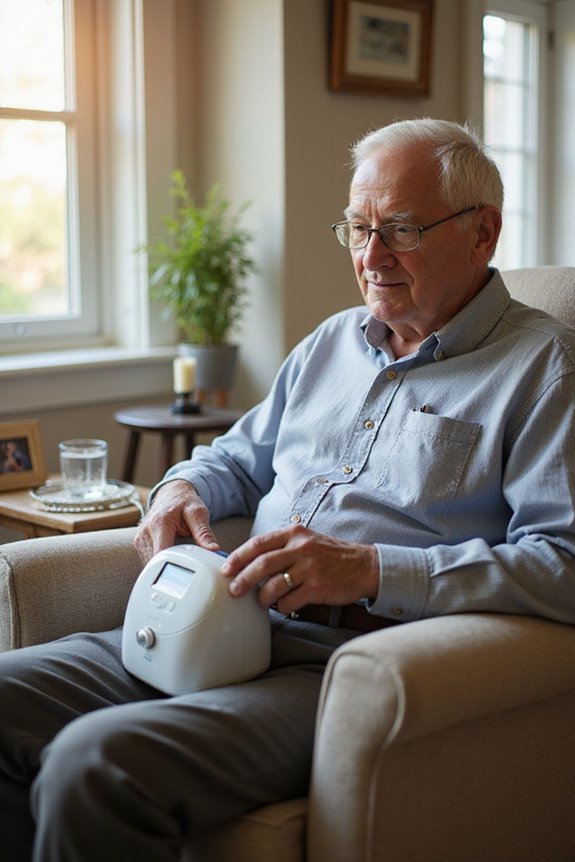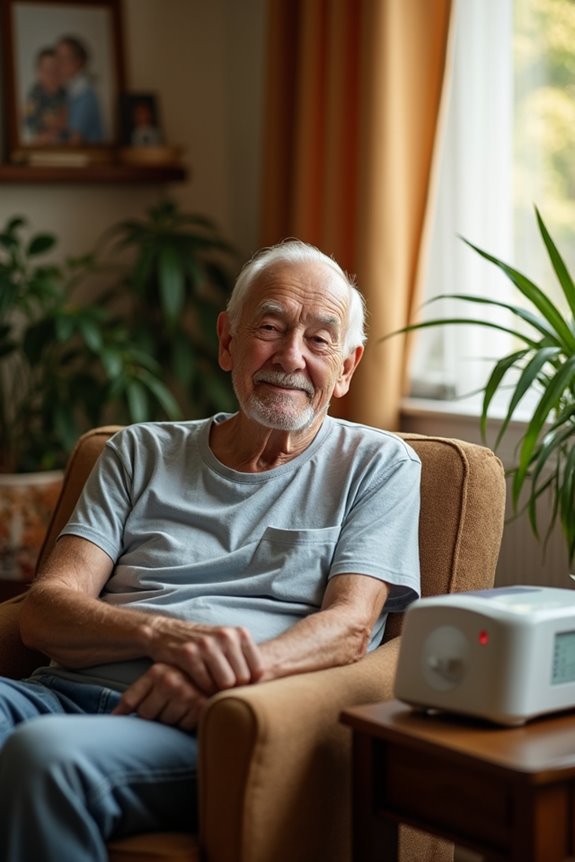To choose an appropriate respiratory therapy device, one must assess the patient’s specific respiratory condition. Key factors include:
- Device type (PEP, HFCWO, oral oscillation).
- Customizable features (expiratory resistance settings).
- Performance metrics (oscillation index, flow amplitude).
- User experience elements (interface usability, comfort).
Evaluating clinical effectiveness and cost implications is essential. Final device selection should consider these aspects to enhance therapy outcomes. Further analysis will yield additional insights into ideal device choices.
Key Takeaways
- Assess the type of respiratory condition (obstructive or restrictive) to determine the most suitable device features and functionalities.
- Consider device performance metrics like oscillation index and flow amplitude for effectiveness in treating specific respiratory issues.
- Evaluate usability features, including compatibility with nebulizers and ease of maintenance, to enhance patient compliance and reduce technical difficulties.
- Review clinical effectiveness data for devices, focusing on patient outcomes and recovery metrics relevant to specific respiratory conditions.
- Analyze cost implications, including device durability and consumable expenses, to ensure long-term financial viability and accessibility.
Understanding the Patient’s Respiratory Condition
Understanding the patient’s respiratory condition is essential for effective treatment and management. A thorough patient history and symptom evaluation are critical in classifying respiratory diseases into obstructive and restrictive types.
- Obstructive Conditions: These include asthma and COPD, characterized by airflow limitation due to airway narrowing. Symptoms often include wheezing and difficulty exhaling.
- Restrictive Conditions: Examples are pulmonary fibrosis, leading to reduced lung volumes and impaired expansion. Patients frequently report sensations resembling tightness in the chest.
- Diagnosis: Utilizes pulmonary function tests, imaging, and histopathology to determine the specific nature of the condition.
Accurate understanding of these classifications not only aids in diagnosis but also informs treatment strategies and device selection for ideal patient outcomes.
Evaluating Device Types and Features
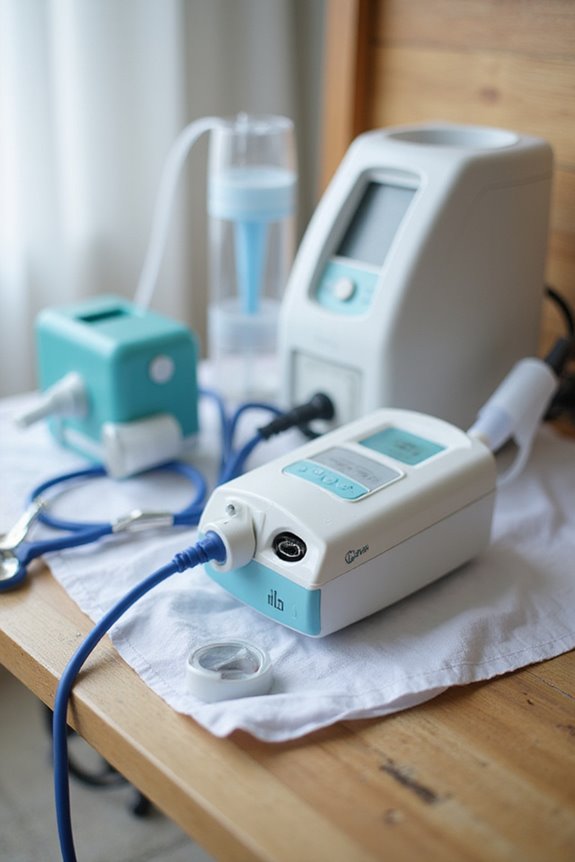
Evaluating the types and features of respiratory therapy devices is integral to optimizing patient care. Various devices include Positive Expiratory Pressure (PEP) devices, High Frequency Chest Wall Oscillation (HFCWO) vests, and oral oscillation devices.
Key considerations in device selection involve:
- Customizable Features: Devices like Acapella offer adjustable expiratory resistance for therapy customization.
- Performance Metrics: Oscillation index, flow amplitude, and frequency are critical for determining effectiveness.
- Usability: Compatibility with nebulizers and gravity independence enhance versatility.
- Patient Needs: HFCWO devices are standard for cystic fibrosis, while other devices cater to diverse respiratory conditions.
Selecting the right device requires careful evaluation of these features to align treatment with individual patient needs and preferences.
Assessing Performance and User Experience
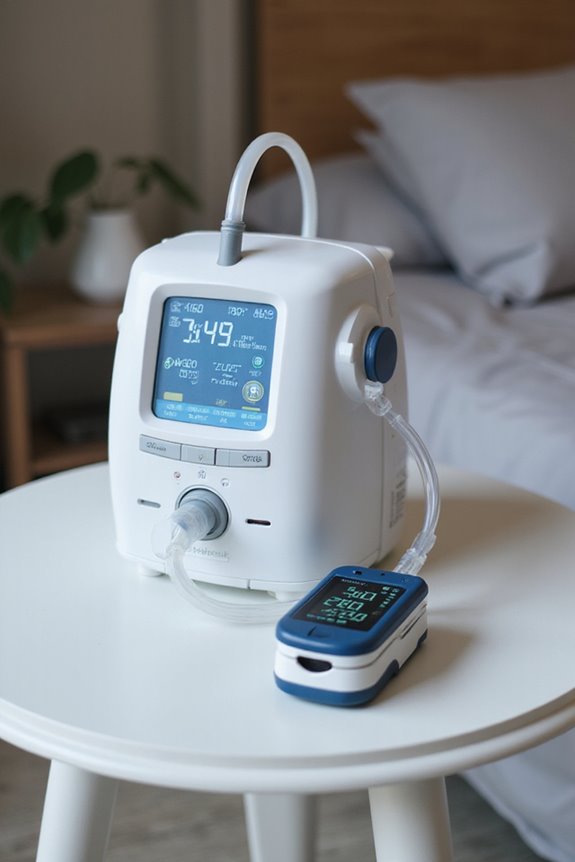
How can evaluating performance and user experience enhance the effectiveness of respiratory therapy devices? By focusing on performance metrics and user feedback, healthcare professionals can make informed decisions.
Key Considerations:
- Accuracy and Sensitivity: Devices with high accuracy and sensitivity minimize false negatives, essential for conditions like asthma and COPD.
- User-Friendliness: Intuitive interfaces reduce operator errors and improve efficiency, accommodating various skill levels.
- Data Management: Effective systems enable longitudinal tracking of respiratory health, enhancing treatment adjustments.
- Compliance: Comfortable, easy-to-use devices increase patient adherence, important for long-term therapy success. Additionally, performance metrics such as adjustable flow rates provide tailored therapy options that can significantly improve patient outcomes.
Clinical Effectiveness and Outcomes
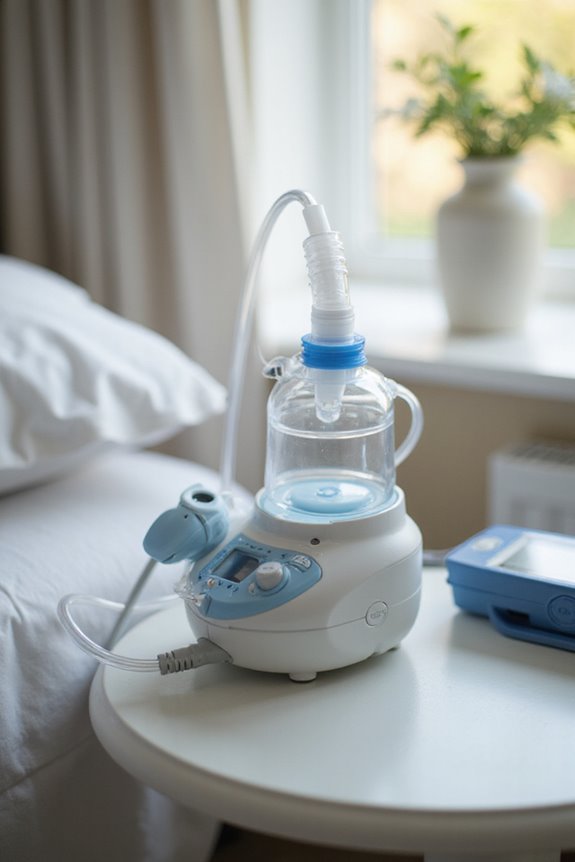
Clinical effectiveness of respiratory therapy devices plays an essential role in determining patient outcomes, as the selection of appropriate technology can greatly influence recovery trajectories. The efficacy of devices, such as CPAP, has been shown to reduce intubation and mortality rates compared to conventional oxygen therapy.
Key points include:
- Primary outcomes: Tracheal intubation rates and 30-day mortality are critical measures.
- Device comparison: Studies indicate CPAP outperforms HFNO and conventional oxygen therapy in specific contexts.
- Adverse events: CPAP may present a higher rate of adverse events compared to other devices.
- Condition-specific effectiveness: Devices like HFCWO are effective for chronic lung diseases, including COPD and cystic fibrosis.
Understanding these factors is critical for optimizing clinical outcomes.
Considering Patient-Specific Needs
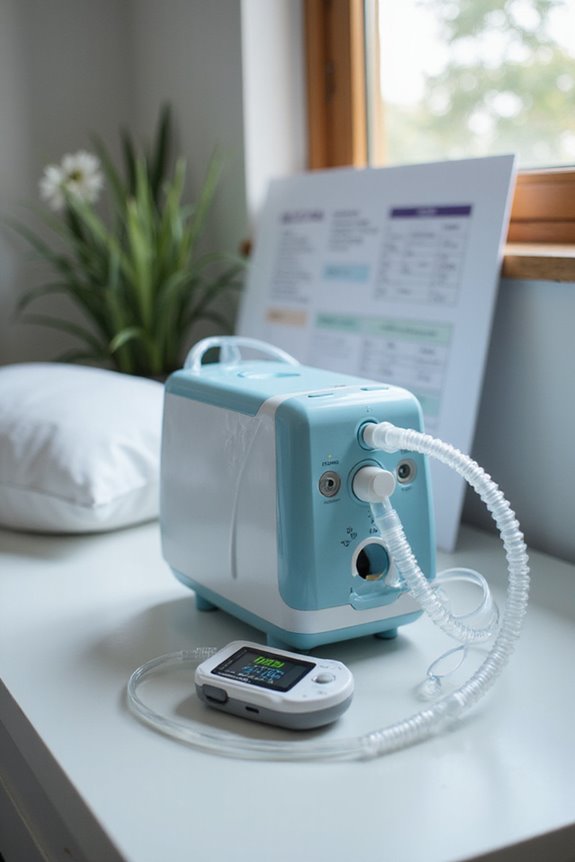
Patient-centered care necessitates a thorough understanding of individual needs when selecting respiratory therapy devices. Considerations include:
- Patient Demographics: Age, cognitive abilities, and manual dexterity greatly impact device selection. Pediatric or elderly patients may require simpler devices.
- Cognitive Impairment: Patients with cognitive challenges benefit from devices that are easy to operate and require minimal steps.
- Disease Severity: More advanced devices may be necessary for severe respiratory conditions, aligning with the patient’s ability to perform the required inhalation maneuver.
- Symptom Management: Devices should effectively manage symptoms and enhance quality of life.
- Lifestyle Compatibility: Device convenience and portability are essential for adherence, especially for those who travel frequently. Additionally, portable options facilitate use during travel and emergencies, ensuring that patients can maintain their therapy regardless of location.
In all cases, thorough assessment by healthcare providers guarantees ideal device selection.
Practical and Economic Factors
When evaluating respiratory therapy devices, practical and economic factors play an essential role in ensuring effective treatment delivery.
Cost Analysis
- High-flow oxygen therapy (HFOT) demonstrates lower total healthcare costs—approximately £364 savings pre-intubation and £144 post-intubation.
- Consumables such as masks and filters greatly impact ongoing expenses; effective inventory management can minimize waste.
Device Maintenance
- Durability of devices influences long-term cost-effectiveness; frequent replacements increase overall costs.
- Simplified maintenance can improve patient adherence and reduce technical support demands.
Service Provider Costs
- Respiratory therapists’ labor costs range from $29 to $39 per hour, impacting operational budgets.
- Ongoing staff training and administrative support contribute to indirect therapy costs, necessitating careful budgeting.
Making the Final Decision
Determining the most suitable respiratory therapy device requires a thorough assessment of various factors that influence patient outcomes. Key considerations include:
- Patient Preferences: Engage patients in discussions about their comfort and ability to use the device effectively.
- Device Compatibility: Verify the selected device aligns with the patient’s respiratory function and medication needs, including specific inspiratory flow requirements.
- Clinical Assessments: Evaluate disease severity, comorbidities, and cognitive function, as these affect device usability.
- Training and Proficiency: Confirm that patients demonstrate correct device usage post-training, while healthcare providers also exhibit proficiency.
Final decisions should reflect a detailed evaluation of all these aspects, focusing on long-term adherence and aligning with patient needs. Regular reassessment is essential as conditions evolve.
Frequently Asked Questions
How Can I Ensure Proper Device Hygiene and Maintenance?
To guarantee proper device hygiene and maintenance, individuals should follow key maintenance tips, including regular device cleaning, thorough inspections, and adherence to manufacturer guidelines. This fosters a community of safety and care among users.
What Should I Do if the Device Causes Discomfort?
Like a sculptor refining a masterpiece, one must embrace device adjustment and comfort strategies to alleviate discomfort. Regularly reassessing fit, pressure points, and material can transform the experience, fostering a sense of belonging and well-being.
Are There Age Restrictions for Using Specific Devices?
Age considerations greatly influence device restrictions for respiratory therapy. Specific devices are recommended based on age groups, ensuring safety and effectiveness. Understanding these guidelines helps caregivers select appropriate equipment for best patient outcomes across different age ranges.
How Long Does It Take to Notice Improvements?
Studies indicate that noticeable improvements can occur within weeks, influenced by adherence and technique. Symptom tracking over the improvement timeline reveals enhanced respiratory function, fostering a sense of community among patients sharing similar experiences.
Can Devices Be Used During Exercise or Physical Activity?
Devices can indeed be used during exercise, enhancing physical activity by maintaining airway openness and aiding mucus clearance. Exercise considerations include device compatibility, patient capabilities, and clinician guidance to guarantee safe and effective usage throughout activities.

